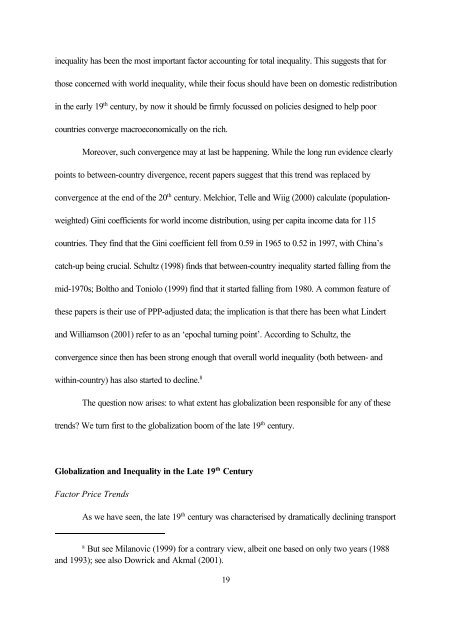Globalization and Inequality - Trinity College Dublin
Globalization and Inequality - Trinity College Dublin
Globalization and Inequality - Trinity College Dublin
You also want an ePaper? Increase the reach of your titles
YUMPU automatically turns print PDFs into web optimized ePapers that Google loves.
inequality has been the most important factor accounting for total inequality. This suggests that for<br />
those concerned with world inequality, while their focus should have been on domestic redistribution<br />
in the early 19 th century, by now it should be firmly focussed on policies designed to help poor<br />
countries converge macroeconomically on the rich.<br />
Moreover, such convergence may at last be happening. While the long run evidence clearly<br />
points to between-country divergence, recent papers suggest that this trend was replaced by<br />
convergence at the end of the 20 th century. Melchior, Telle <strong>and</strong> Wiig (2000) calculate (populationweighted)<br />
Gini coefficients for world income distribution, using per capita income data for 115<br />
countries. They find that the Gini coefficient fell from 0.59 in 1965 to 0.52 in 1997, with China’s<br />
catch-up being crucial. Schultz (1998) finds that between-country inequality started falling from the<br />
mid-1970s; Boltho <strong>and</strong> Toniolo (1999) find that it started falling from 1980. A common feature of<br />
these papers is their use of PPP-adjusted data; the implication is that there has been what Lindert<br />
<strong>and</strong> Williamson (2001) refer to as an ‘epochal turning point’. According to Schultz, the<br />
convergence since then has been strong enough that overall world inequality (both between- <strong>and</strong><br />
within-country) has also started to decline. 8<br />
The question now arises: to what extent has globalization been responsible for any of these<br />
trends? We turn first to the globalization boom of the late 19 th century.<br />
<strong>Globalization</strong> <strong>and</strong> <strong>Inequality</strong> in the Late 19 th Century<br />
Factor Price Trends<br />
As we have seen, the late 19 th century was characterised by dramatically declining transport<br />
8<br />
But see Milanovic (1999) for a contrary view, albeit one based on only two years (1988<br />
<strong>and</strong> 1993); see also Dowrick <strong>and</strong> Akmal (2001).<br />
19
















